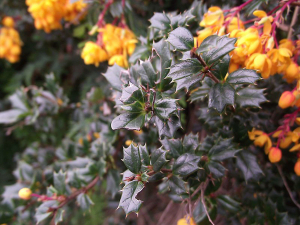EPA chief executive to step down
Allan Freeth, chief executive of the Environmental Protection Authority (EPA) has announced he is resigning.
 Darwin’s barberry is a resilient noxious weed found in disturbed forests, pastures, shrubland and short tussock-land.
Darwin’s barberry is a resilient noxious weed found in disturbed forests, pastures, shrubland and short tussock-land.
The Environmental Protection Authority (EPA) has approved a rust fungus and a flower weevil to control Darwin’s barberry, a spiny invasive shrub.
Environment Canterbury, on behalf of the National Biocontrol Collective, applied to use two biological control agents to combat Darwin’s Barberry in New Zealand.
Darwin’s barberry is a resilient noxious weed found in disturbed forests, pastures, shrubland and short tussock-land. It is considered a threat to indigenous ecosystems throughout the country, as well as pastures where livestock graze.
Standard control methods like herbicides or weeding can prove costly, impractical and harmful to the environment.
It is native to Chile and Argentina and was introduced into New Zealand as a garden plant in the 1940s. Fruit-eating birds deposit seeds far from the parent bush, increasing its spread.
The plant can be found throughout New Zealand – particularly in the Canterbury, Otago, and Wellington regions.
The proposed biocontrol agents could also be used to target Darwin’s barberry elsewhere in the country.
Both the flower weevil and the rust fungus proposed for introduction are native to South America.
All organisms new to New Zealand must receive approval from the EPA before being released into the New Zealand environment.
Dr Chris Hill, general manager of hazardous substances and new organisms at the EPA, says the independent decision-making committee approved the introduction of the new organisms following “rigorous, evidence-based assessment”.
“The applicant’s risk assessment showed that these agents are highly unlikely to harm native plants or animals,” Hill says.
“The weevil does not bite or sting, so there is no health risk to people, and the rust fungus is also benign,” he adds.
Hill says the decision followed public consultation, engagement with mana whenua, and consideration of international best practice.
“New Zealand has a strong track record of using biological control agents to manage invasive weeds with minimal impact on native ecosystems," he concludes.
The Government is set to announce two new acts to replace the contentious Resource Management Act (RMA) with the Prime Minister hinting that consents required by farmers could reduce by 46%.
Prime Minister Christopher Luxon says withdrawing from the Paris Agreement on climate change would be “a really dumb move”.
The University of Waikato has broken ground on its new medical school building.
Undoubtedly the doyen of rural culture, always with a wry smile, our favourite ginger ninja, Te Radar, in conjunction with his wife Ruth Spencer, has recently released an enchanting, yet educational read centred around rural New Zealand in one hundred objects.
Farmers are being urged to keep on top of measures to control Cysticerus ovis - or sheep measles - following a spike in infection rates.
The avocado industry is facing an extremely challenging season with all parts of the supply chain, especially growers, being warned to prepare for any eventuality.

OPINION: Your old mate welcomes the proposed changes to local government but notes it drew responses that ranged from the reasonable…
OPINION: A press release from the oxygen thieves running the hot air symposium on climate change, known as COP30, grabbed your…